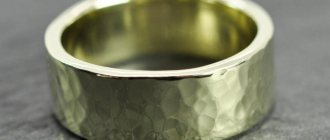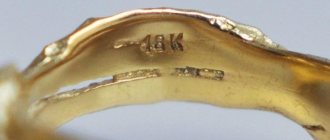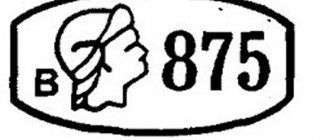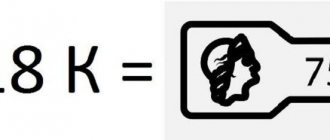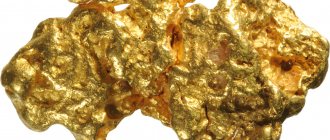The world's largest gold bar is located in one of the Japanese museums. It weighs 250 kilograms and costs more than $3 million. This metal has always been desirable and expensive, not only due to its beauty, but also due to a number of useful properties for people, which include the fact that it does not oxidize, does not tarnish, serves as a conductor and is used in medicine as an antiseptic.
However, its main area of application is monetary relations. Gold bullion is the world's hardest currency because, unlike money or securities, it cannot lose value.
You can buy them for investment purposes at any large bank, however, before making a purchase, you should find out more about them so as not to make a mistake with your choice. You should know that there are measured and standard gold bars, as well as the standards of Russian manufacturers according to which these bars are manufactured. Overseas smelters follow their own standards set by the London Platinum and Palladium Market, abbreviated LPPM, and the London Bullion Market Association, abbreviated LBMA, referred to as the “London good delivery” standard.
Types of ingots
Gold bars are used as an investment object, raw material for making jewelry, and gifts. Depending on the method of application, the metal is given different weight, shape and appearance. Refineries are engaged in the production of such products.
Measured
Bullion bars are intended for individuals and can be bought and sold at a bank or jewelry store. For ease of circulation, they are issued in different weights, similar to the denominations of banknotes.
Standard
The standard version is not intended for everyday use. Its purpose is as raw material for jewelry workshops and factories, so the form of their production is not very diverse.
Technological differences
The methods for making such things also differ. Small products - up to 50 grams - are produced using stamping. The surface of the metal turns out to be very beautiful - smooth and neat, with perfectly executed details of inscriptions and drawings.
Larger specimens are produced by casting. The appearance of cast products is not so perfect, but this manufacturing method is cheaper.
There is also a powder production method - by electrolysis, but it is not used in Russia.
Physical form of investing in gold
In ancient times, identification marks were placed on valuable metals. In the modern world, different types of stamps are also used. But standardized signs were introduced centuries ago. Before that, each manufacturer put their own stamps and engravings.
Thanks to branding, the purchase and sale system has been simplified. Gold has become even more widespread; today it is one of the investment instruments.
It is distinguished by a set of properties:
- stability in the long term: the price is maintained even in difficult times (when disasters, wars, economic crises occur), while its slight decrease is possible, but even then Au remains the most valuable resource for which goods and services can be exchanged;
- divisibility: the production of coins and bars does not change their properties, they are just as valuable as a large piece of precious metal or a nugget;
- preservation of physical properties: valuable metal does not lose its attractiveness and is not subject to corrosion.
For investment, different types of bars are used. They are standardized and must comply with GOST parameters. It is permissible to produce ingots to order; they may differ in size and weight. The stigma is also different in this case. Sometimes such products are even marked with a portrait of the owner.
Bank coins
Coins vary in type of material, weight and size. They are produced in series and may have a name. A separate category presents those that are produced in limited quantities. The price of this type of valuable metal is higher than those coins that are produced in large quantities. It is believed that investment gold should have the highest value (high purity), but there are different hallmarks starting from 900. Among them there are also non-standard options. But the most popular products are 999. They are also the most valuable. Accordingly, the cost of such coins is higher.
Ingot weight and dimensions
In Russia, ingots weighing 1, 5, 10, 20, 50, 100, 250, 500 and 1000 g are produced. Foreign-made products also come in weights of 2, 2.5 grams. 1 troy ounce is often found, equal to 31.1 grams.
International measure
The most common measure for gold abroad is the troy weight system. In bank accounts, gold can be recorded in both the metric system (grams, kilograms) and ounces. This system is used not only for precious metals: it is used in pharmacy and cosmetology to account for particularly valuable components.
Requirements for the gold bar standard
The list of requirements is regulated by GOST R 51572-2000. The document contains dimensions and maximum weight deviations from the norm, regulates the absence of cracks, foreign elements, damage and contamination, and lists permissible deformations that occur during production.
Each product has its own unique number, which is certainly indicated directly on the ingot. In addition, mandatory information is applied to the metal using markings:
- a stamp in the form of an oval with the inscription “Russia”;
- exact weight;
- the inscription "Gold";
- noble metal sample;
- brand of the refinery manufacturer.
All inscriptions must be on the title side of the product and be legible. Corrections or merging of letters are not allowed in the text. The presence of defects is the reason for the decrease in the value of a precious item.
However, such requirements are not mandatory. Gold can have any shape, weight and size in case of individual customer requirements.
Weight of a standard ingot in kg in Russia
The requirements are regulated by GOST 28058-89. Permissible weight – from 11 to 13.3 kilograms. The shape of the products is a bar in the form of a truncated pyramid. The document also determines the grade of metal, appearance without defects, permissible deformation and a list of data printed on gold.
Gold bar sizes 1 and 10 kg
The size established for a kilogram measured product: length 105-116 mm, width 48-52 mm. The height of the object is not regulated.
The following proportions are used in standard samples (with a permissible deviation of ± 5 mm):
- larger base, mm – length 54, width 88;
- smaller base, mm – length 229, width 59;
- height – 35 mm.
Weight of a gold bar in storage
The precious metal of the Russian Gold and Foreign Exchange Reserve is stored mainly in objects weighing from 1 to 14 kg.
The United States prefers to store its savings in the form of bars weighing 400 troy ounces, or 12.44 kg.
How much does the largest bar weigh today?
The largest specimen in the world belongs to Japan. Its weight is 250 kilograms, which is even recorded in the famous Guinness Book of Records.
In second place is Taiwan, the happy owner of a piece of gold weighing 220 kg.
Recommended prices for gold, silver, platinum and palladium at the London fixing
There are currently 5 exchanges in the world dealing in precious metals, the main one being the London exchange – LME.
Twice a day, prices for gold and silver are fixed on this site (since 1987), which are the main reference point for other exchanges and dealers of precious metals.
Platinum and palladium futures are also traded on the LME.
Buying and selling
Trading in this product is primarily the prerogative of banks. You can not only buy gold there, but also leave it for storage. Such a financial investment has a high level of profitability, but only in the long term, since the purchase price will be higher than the sale, as with other foreign exchange transactions.
Expert opinion
Lyudmila Pestereva
Our most experienced gold investor
Ask a Question
Such an acquisition is subject to VAT, and upon sale the owner is charged income tax. However, these fees will be canceled if more than 3 years have passed since the date of purchase. Therefore, it will be beneficial not only not to sell gold before this period, but not even to withdraw it from the bank.
What determines the price of a bank bullion?
In addition to the current gold rate, the price of the product is tied to its weight. The buyer pays the most money if he purchases metal weighing 1 gram. The higher the weight of the ingot, the cheaper the gold is per gram.
When selling gold to a bank, some financial institutions, for example Sberbank, provide an additional commission, which increases in proportion to the weight of the item being handed over.
Products in poor condition, on the contrary, are accepted at banks, charging an additional commission of about 3% of the value of the metal.
How much does a gold bar cost in Russia 1 gram and 1 kg
As of today. 1 gram of gold costs:
| Price 999 standard according to the Central Bank | Market value of the sample today | Scrap price | Price in jewelry |
For an ingot weighing 1 kilogram you will have to pay (in million rubles):
USDRUB*GC1!*10000000/311034 chart courtesy of TradingView
Where is the best place to buy bullion?
It is always better to purchase such things from financial institutions. In this case, the possibility of forgery is eliminated and the availability of the entire package of accompanying documents is guaranteed.
Where and how to store the bullion
The storage of gold, including in coins, should also be entrusted to the bank. It’s not safe to keep such valuables at home, and there’s no point in keeping them. The financial institution opens a metal safekeeping account for the client - an analogue of a safe deposit box. You can put all your precious savings there, add new ones or withdraw the necessary part.
The cost of such a service will not depend on the number of items, their weight and even the metal from which they are made - all your savings in precious metals can be kept in one place.
To see how Russia's gold reserves are stored, watch the video:
Gold Investments
At all times, experienced people kept a certain part of their money in gold equivalent and thus avoided economic problems during all kinds of crisis situations. It is a safe and stable investment whose main purpose is to preserve the value of money.
Gold bullion is a great option for storing money for those who are tired of constantly checking financial news and price jumps, as there is no need for it. For quick enrichment, gold is not the most suitable option, since it is designed for the long term.
Reviews
I purchased an ingot (only 10 g), I keep it in a secluded place - I will not voice it so that it continues to remain secluded. Initially I planned to accumulate valuable metal in order to invest money in this way, but now I have more information, so I don’t really believe in this method of getting rich. Rather, it is suitable for wealthy people who want to save their existing money rather than earn money.
Vitaly N., Yaroslavl
Linda G., Sochi
I was in the UAE and saw an attraction there - a type of slot machine: inside a transparent box with holes for hands there is a real jewel - a gold bar. It is problematic to get it, because it is difficult to lift it. I could not. I would never have thought that such metal could be so heavy.
Precious metals weigh a lot, I have noted this to myself more than once. I was looking for something valuable to invest money for my boss. I found where to buy it, checked the quality (at work I often have to deal with such things). So I wouldn’t take it for myself. I didn't like how much preparation it took to store it. And it doesn’t matter where: at home or in a bank – it’s still an expensive pleasure.
Gleb L. g, Kastroma
Asset storage options
Common ways to preserve precious metals:
- leave it with you, but this option should be chosen only if there is a safe, otherwise you can lose valuables during theft, since robbers usually know about all the secluded places that the owners consider safe in their home;
- store in a bank: immediately after purchase, you can leave the Au there - in a storage facility; you need to sign an agreement that will contain all the conditions, but you will have to pay for such a service.
Can the 999 sample be considered pure?
Before finding out how much a 999 gold bar weighs and its key parameters, it is advisable to determine the purity of such a product. To begin with, it should be noted that absolutely pure gold does not exist in nature, and only metal with varying proportions of impurities in its composition can be obtained industrially.
Such ingots are called “4 nines”, since the content of the base metal in them reaches 99.99%. Such products can be considered standard, since they seem to be the purest of all products available to investors. Thanks to such features, they are widely used by government financial institutions - Central banks of various countries to create funds.
To improve the quality of finished products, they are subjected to various cleaning methods, including both physical and chemical ones. Such material is rarely used in jewelry products, since its distinguishing features are extremely high cost and low strength. Because of this, products with a lower proportion of gold and higher resistance to deformation have become widespread.
Material properties
Despite the fact that most consumers associate gold with a yellow metal, in its natural form it can be found in a variety of forms. As a rule, the sizes of this type of natural metal vary from small particles to medium-sized nuggets.
Because they contain a high proportion of impurities, their color can vary from greenish to gray, making them difficult to identify . Only high quality material has a bright yellow color, the amount of impurities in which is extremely small. This metal is soft - this property has been used since ancient times to determine the quality of gold.
The melting point of the high-grade product is 1063 degrees Celsius, and the boiling point of the material is located at 2947 degrees.
It is important to consider that when melted, gold changes its color to light green, and when boiled, the vapor will have shades from yellow to green.
High-grade gold is widely used in the manufacture of various alloys, which makes it possible to achieve characteristics more suitable for the production of jewelry. As additives, as a rule, silver, copper, nickel, zinc and other materials are used, which significantly increase the strength of the alloy and reduce the ductility.
If we consider the density of a 999 gold bar, we should remember that it is about 19.3 g/cm3. Similar values are typical for pure material without impurities, however, nuggets found in nature have a lower density - about 18.5 g/cm3. This difference is due to the presence of impurities that affect the properties of the metal.
